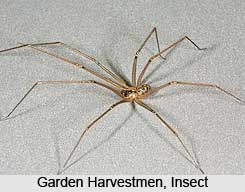 Garden Harvestmen (Phalangid) are arachnids with a small flattish, oval body which is six to seven millimetres long and four pairs of thin long legs measuring sixty to ninety millimetres long. Because of their long legs they are called Daddy-Long-Legs. They are often mistaken for spiders from which they sharply differ in the absence of silk glands and spinnerets and in having their abdomen segmented and fused with the cephalothorax.
Garden Harvestmen (Phalangid) are arachnids with a small flattish, oval body which is six to seven millimetres long and four pairs of thin long legs measuring sixty to ninety millimetres long. Because of their long legs they are called Daddy-Long-Legs. They are often mistaken for spiders from which they sharply differ in the absence of silk glands and spinnerets and in having their abdomen segmented and fused with the cephalothorax.
These insects appear in huge assemblages during the harvest season in India and for this reason they got their name `Garden Harvestmen`. It is a sight to see hundreds of them clinging to the herbage with their legs and rocking their bodies up and down in unison. At the slightest interruption they break the assemblage and scurry helter-skelter. They are good hunters. With their long legs they speedily span over leaves and grass and outmanoeuvre their prey - mainly small insects. They are generally darkish grey but in many species the colour matches with the surroundings. They also feed on insect larvae, spider lings, mites and their own young ones. They not only suck the juice of their prey but also chew and swallow solid particles. Juices of fruits and vegetables are also sucked by them.
At the time of breeding season, males fight among themselves to win the female. The pregnant female spins no cocoon for her eggs but lays them in crevices on the ground, under stones or fissures of bark. In cold and temperate countries this takes place towards the end of autumn, after which the adult die. The eggs survive during winter, hatch out in spring and become adults in summer. In India, hot summer and heavy rains reduced the population of these creatures. They are, however, found in plenty during the months of August to March. Common genera are Phalangium and Liobunum.
This article is a stub. You can enrich this article by adding more information to it. Send your write up at content@indianetzone.com



















